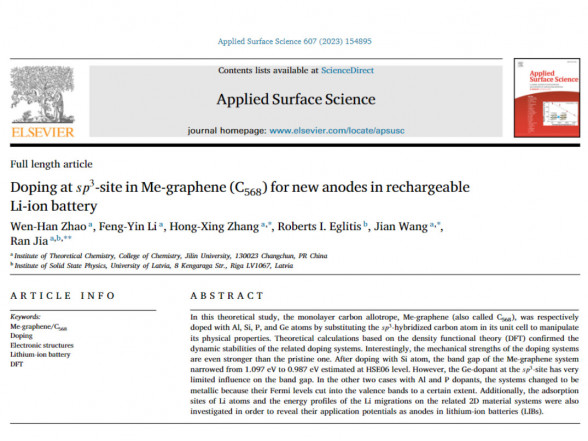In its January 2023 issue (607), the scientific journal Applied Surface Science (impact factor 7.32) will publish an article co-authored by the leading researcher of the ISSP UL’s Laboratory of Computer Modeling of Electronic Structure of Solids, Dr. Phys. Roberts Eglītis. The name of the publication is “Doping at sp3 -site in Me-graphene (C568) for new anodes in rechargeable Li-ion battery“.Other authors of the article are researchers from the Institute of Theoretic Chemistry, Jilin University, China W.H. Zhao, F.Y. Li, H.X. Zhang, J. Wang, R. Jia.
This article is devoted to the theoretical study of the monolayer carbon allotrope, Me-graphene (also called C568). Researchers describe the process of investigation – doping the monolayer allotrope with Al, Si, P, and Ge atoms by substituting the sp3 -hybridized carbon atom in its unit cell to manipulate its physical properties. The authors conclude that the theoretical calculations based on the density functional theory (DFT) confirm the dynamic stabilities of the related doping systems.
The second article in Applied Surface Science is made available online on October 3 and is entitled “Reasonable BN nanotubes composed of B – B and N – N bonds: A theoretical Prediction”. The publication is co-authored by Dr. Phys. Roberts Eglītis and the researchers from the Institute of Theoretic Chemistry, Jilin University, China Feng-Yin Li, Hong-Xing Zhang, and Ran Jia.
In the article, researchers answer the question about the kinds of nanotubes rolled from the rectangular di-BN that could be reasonable. In order to clarify this question, the researchers investigated two types of mathematically and physically rigorous boron nitride nanotubes (di-BNNTs) along the (n,0) and (0,n) chiral vectors, composed of diboron B−B and azo N−N bonds. The study was carried out with the aid of density functional theory (DFT) simulations.
Applied Surface Science covers topics contributing to a better understanding of surfaces, interfaces, nanostructures, and their applications. The journal is concerned with scientific research on the atomic and molecular level of material properties determined with specific surface analytical techniques and/or computational methods, as well as the processing of such structures.



